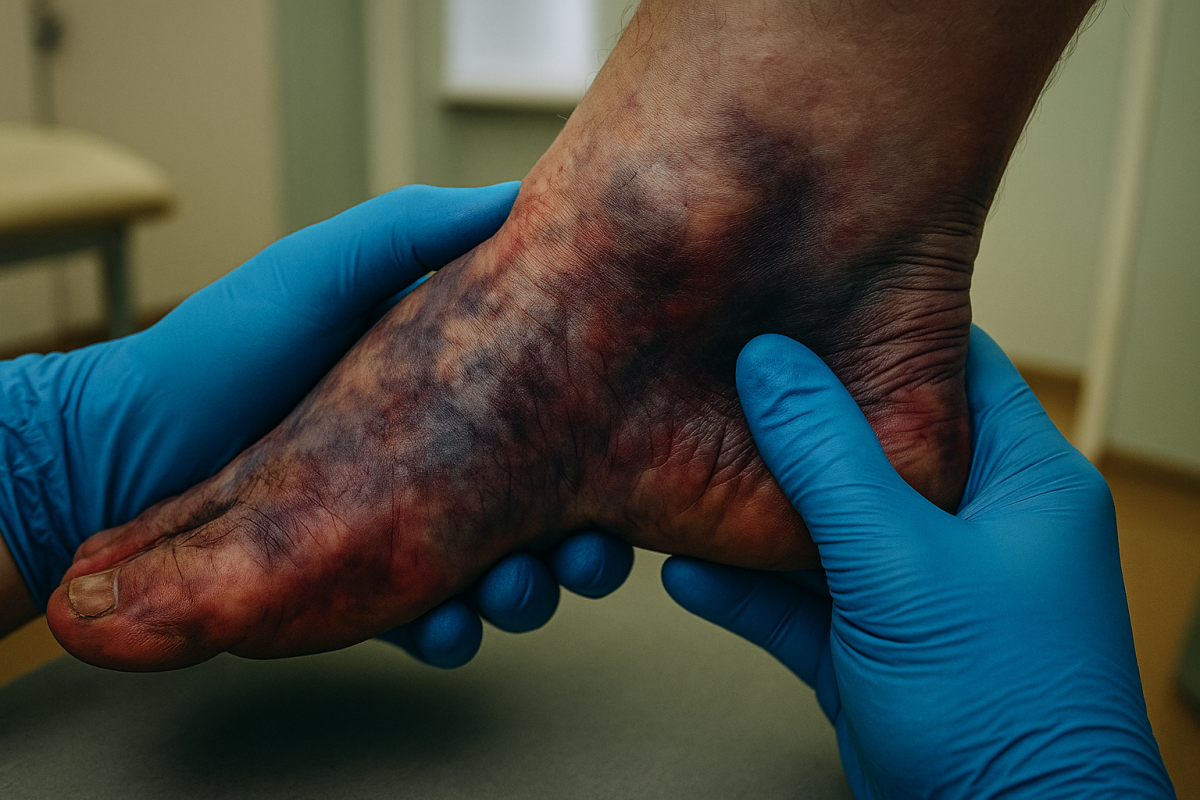 Blue Skin on Your Foot? Doctors Say This Could Be a Silent Killer
Blue Skin on Your Foot? Doctors Say This Could Be a Silent Killer

It started with something so small, I almost didn’t notice it. The skin near my ankle looked… off. Not swollen, not sore, but the color had this strange bluish tint—like a fading bruise that didn’t make sense. I thought maybe I’d knocked into something while rushing around the kitchen or walking the dog. You know how it is. Life moves fast, and you stop keeping track of every bump and scrape.
So I shrugged it off. I’m in my late 40s—random aches and weird little body quirks come with the territory, right? But the next morning, that blue patch was still there. Worse, actually. It had deepened in color and started creeping down toward my foot. My toes felt unusually cold, almost like they’d been out in the snow.
That’s when a little voice inside me whispered, This isn’t normal.
I showed my wife. She leaned in, squinting, and said, “Probably just circulation,” then handed me a blanket. I tried to nod along, but something inside wouldn’t settle. I couldn’t shake the feeling that this wasn’t something to ignore. So, I picked up the phone and called my doctor.
And let me tell you—thank God I did!

One day, I noticed the skin near my ankle looked… off. It wasn’t swollen or painful, but the color was strange—kind of bluish, almost like a bruise that hadn’t healed. I figured I must have bumped into something without realizing it. No big deal, right?
I went about my day, brushed it off, and told myself I was just getting older. I’m in my late 40s, and honestly, weird body changes don’t surprise me much anymore. But the next morning, it was still there—and darker. That dull blue shade had crept further down my foot, and now my toes felt colder than usual.
That’s when the worry crept in.
I showed my wife. She squinted, said, “Maybe it’s just circulation?” and handed me a blanket. But deep down, something didn’t feel right. I called my doctor, and thank God I did.
When I got to the clinic, the nurse looked concerned the second I took off my sock. They ran a Doppler ultrasound on my leg, and within the hour, I had a diagnosis I never expected: deep vein thrombosis—a blood clot. If I had waited even a few more days, it could have broken loose and traveled to my lungs.
The doctor said it bluntly: “This could have killed you.”
It still sends a chill down my spine.
Apparently, a lot of people ignore discolored feet and legs, thinking it’s “just aging,” “bad circulation,” or “no big deal.” But what I learned that day—and what I want everyone reading this to understand—is that your body is trying to tell you something. And sometimes, that little patch of discolored skin is more than just skin deep.
Discoloration can signal:
- Varicose veins – which may look harmless but can lead to blood pooling and serious vein disease.
- Chronic venous insufficiency – when your leg veins struggle to pump blood back up to your heart, causing swelling and color changes.
- Peripheral artery disease (PAD) – reduced blood flow due to narrowed arteries, increasing your risk of heart attacks and strokes.
- Ischemia – which means your tissues aren’t getting enough oxygen and can literally start to die.
- Or, like me, a dangerous clot hiding in plain sight.
None of these conditions should be ignored—especially if you’re over 40. Our bodies aren’t invincible. What seems like a cosmetic issue could actually be a red flag waving frantically beneath the surface.
The crazy thing is, I almost didn’t call the doctor. I almost convinced myself it was nothing, just like so many others probably do. But listening to that little nudge in my gut may have saved my life.
If you notice unusual coloring in your feet or lower legs—blue, purple, or even reddish tones that don’t fade—don’t wait. Don’t hope it goes away. See a doctor. Ask questions. Demand answers.
Because early action can make all the difference. I’m living proof of that.
Now, I check my feet and legs regularly. Not in a paranoid way—but as a habit. A healthy, life-saving habit. I tell my friends to do the same. Because that little patch of blue? It wasn’t just a color. It was a warning—and I’m lucky I listened.
Related posts
- 10 Things Politicians Always Promise to Fix — But Never Do - Really Viral , politics
- Healthy Recipes for Fat-Burning Soup - Really Useful
- 8 Actors Who Played Villains Too Well That They Were Hated IRL - Really Famous , celebrities , movies
- What are the benefits of lettuce - Really Useful
- How do I spend my time on vacation? - Really Adventurous
Latest posts
- She Lost 160 Pounds With Ozempic, But That's Only Half the Story - Really Inspirational , Amy Kane , fitness , weight loss
- 9 Movies About The Devil You Need To Watch - Really Binge-Worthy , movies
- 10 Animals That Refuse To Die Like Normal Creatures - Really Weird , amazing , animals
- These 9 Spy Gadgets from Movies Are Cooler Than Anything in Real Life - Really Geeky , movies
- 8 Retro Gadgets That Made a High-Tech Comeback - Really Geeky , technology
- 8 Actors Who Played Villains Too Well That They Were Hated IRL - Really Famous , celebrities , movies
- Groom and Bride's Dad Go Viral for Getting Super Emotional - Really Viral , bride , wedding
- Wild Avril Lavigne Doppelganger Theory That Just Won't Die - Really Conspirious , Avril Lavigne , Avril Lavigne died , celebrities
- 10 Things Politicians Always Promise to Fix — But Never Do - Really Viral , politics
- Was the Moon Landing Real or Fake? - Really Conspirious , NASA , space